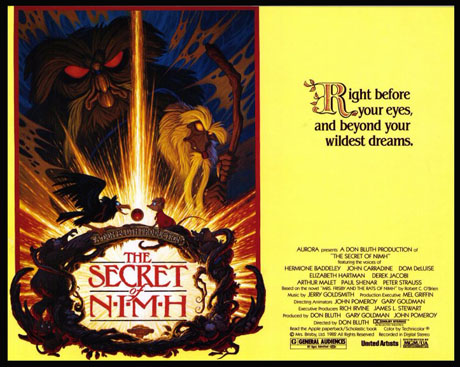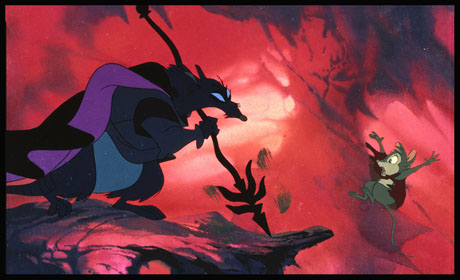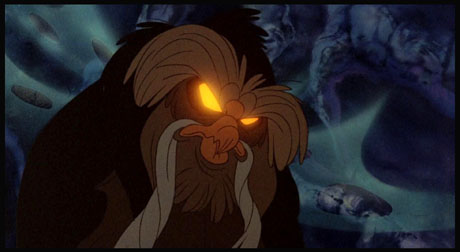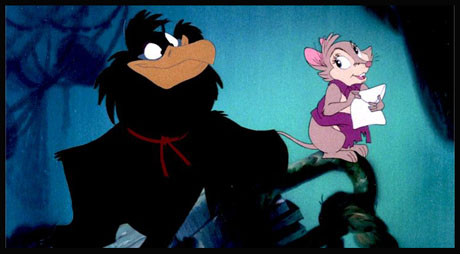
For many following animation closely in 1982, The Secret of NIMH was more than just another summer movie. A lot was riding on this animated film that was opening amidst other blockbusters like E.T. The Extra-Terrestrial and Rocky III.
It was the first feature directed by Don Bluth. His name had become well-known just several years prior. In 1979, Bluth led a walk-out of about half a dozen animators from the Walt Disney Studio, the place synonymous with classic animated feature films that had become beloved by generations.

Bluth and a group of artists had become dissatisfied with the Disney Studio and believed that animation could do better and be better. They all left to do just that with their studio.
The Secret of NIMH would be their proving ground.
Based on the 1971 book, Mrs. Frisby and the Rats of NIMH. The main character of the film is Mrs. Brisby. The name was changed to avoid confusion and legal complications with the toy Frisbee. Brisby is a widow and lives in a cinder block with her children. She must move, as the field she lives in is about to be plowed.
She enlists the guidance of The Great Owl and a colony of rats to help her relocate her family. While visiting the rats, she learns that her husband, Jonathan, was used for experiments in a laboratory by the National Institute of Mental Health (NIMH).

The experiments performed on the mice boosted their intelligence, allowing them to read and understand how to use machinery. As Jonathan aided the rats, they agree to help Mrs. Brisby move her family. Nicodemus, the leader of the rats, even bestows a magical amulet to Mrs. Brisby, which will activate under courageous situations. She may just need it, as the villain, a rat named Jenner, has other plans beyond helping Brisby to move her family.
The animation in The Secret of NIMH is gorgeous. Bluth’s goal was to re-create the look so prevalent in Disney’s Golden Age animated films, which is reflected here. The character design is most definitely in the Disney style and bared a striking resemblance to that used by the studio.
The results are excellent, particularly as the style merges with the performances: the emotion and empathy of Mrs. Brisby come across very well, especially in her desperate acts during the conclusion; the comic relief of Jeremy the crow has entertaining moments, especially while attempting to get untangled from some string, and the imposing characters of The Great Owl and Nicodemus are beautiful examples of character craftsmanship.

The Secret of NIMH features an impressive cast of respected and veteran character actors whose performances are used well to bring the personalities to life. These include Elizabeth Hartman as Mrs. Brisby, Derek Jacobi as Nicodemus, Paul Shenar as Jenner, and John Carradine as The Great Owl.
Additionally, Peter Strauss portrays Justin, a rat who assists the Brisby family, Hermione Baddeley as neighbor Auntie Shrew, Arthur Malet as Mr. Ages, the reclusive mouse who helps Mrs. Brisby, then-child actors Wil Wheaton and Shannen Doherty as two of the Brisby children, and Dom DeLuise (who would become a Bluth film stalwart) as the comical crow, Jeremy.
While The Secret of NIMH featured recognizable voices like a Disney animated feature, the tenor that Bluth brought to the film was decidedly different. Sequences in the movie have an edgier, darker tone, particularly in the character of Jenner, and a deadly duel toward the film’s conclusion. Additionally, the scenes attempting to move the Brisby house amid a mudslide are harrowing in how they play out.
Also, the subject of laboratory animals adds a gloomier vibe to the proceedings.

Critics were receptive to the film when it opened on July 16th, 1982, and audiences were curious enough to help the movie make over $14 million domestically.
One of those watching The Secret of NIMH was Steven Spielberg, who enjoyed the film so much that he invited Bluth to direct two animated features for him, 1986’s An American Tail and 1988’s The Land Before Time. Both turned out to be two of the most successful animated features of the ‘80s, showing Bluth to be a significant player alongside his once home of Disney, just as the animation industry was on the precipice of a renaissance in the ‘90s.
With The Secret of NIMH, did Bluth, and the other artists who left the Disney studio bring the glory back to animation that they hoped to? Many indeed feel that the feature was a first step in showing that others outside of the “Mouse House” could compete and that audiences would be receptive to new, different visions for animation.
This idea would be reflected in the comments of critic Roger Ebert in 1982, who, in his review, said, “Walt Disney would’ve liked The Secret of NIMH.”
- An Eye for A Classic: The 60th Anniversary of “Mr. Magoo’s Christmas Carol” - December 22, 2022
- A Very Merry Mickey: The 70th Anniversary of “Pluto’s Christmas Tree” - December 19, 2022
- A Fine French Feline Film: The 60th Anniversary of “Gay Pur-ee” - December 12, 2022


 September 5th, 2022
September 5th, 2022  Michael Lyons
Michael Lyons  Posted in
Posted in  Tags:
Tags: 






